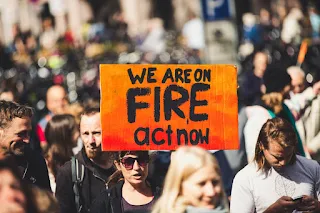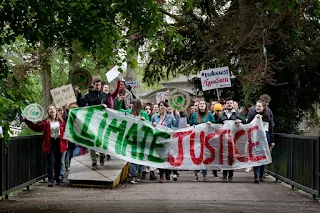According to the UN’s – The international Fund for Agriculture Development (IFAD) Climate change could push more than 100 million people into poverty by 2030, with half of this poverty increase due to climate effects on agriculture.
And it is aggravating existing conflicts and has the potential to cause new conflicts around the world as resources become more limited.
And it is aggravating existing conflicts and has the potential to cause new conflicts around the world as resources become more limited.
In 2018, disasters displaced 17.2 million people from their homes, 90% fled weather and climate-related hazards.
In Africa alone, conflicts have risen by 36% between 2018 and 2019. “This has contributed to an increase in hunger and poverty.
Also Read,
Climate impacts will affect agriculture the most, a key sector in the poorest countries and major source of income, food security, nutrition, jobs, livelihood, and export earning. By 2030, crop yield losses could mean that the food process world is 12% higher on average in Sub-Saharan Africa.
The strain on poor households who spend as much as 60% of their income on food, could be acute. The resulting malnutrition could lead to an increase in severe stunting in Africa of 23%.
The strain on poor households who spend as much as 60% of their income on food, could be acute. The resulting malnutrition could lead to an increase in severe stunting in Africa of 23%.
At the global level, warming of 2.3 degrees Celsius could increase the number of people at risk for malaria by up to 5%, or more than 150 million more people affected.
Diarrhea would be more prevalent, and increased water scarcity would have an effect on water quality and hygiene.
Diarrhea would be more prevalent, and increased water scarcity would have an effect on water quality and hygiene.
The resulting would be an estimated 48,000 additional deaths among children under the age of 15 resulting from diarrheal illness by 2030.
Climate emergencies also dis proportionally affect disabled people because of their inherent vulnerabilities, and people with disabilities are among the most marginalized and at-risk populations in any crisis-affected community.
An estimated 9.7 million people with disabilities are forcibly displaced as a result of conflict and persecution.
An estimated 9.7 million people with disabilities are forcibly displaced as a result of conflict and persecution.
Other severe impacts
A vast majority (~90%) of the excess heat due to global warming is actually stored in the oceans which will also have far-reaching socio-economic impacts.
On the other hand, climate change may provide an economic boost extent, to colder richer countries. Tourism in areas of northern Europe and agriculture in Canada, for example, may see some benefits of rising temperatures.
The authors warn of non-linear impacts once the crucial threshold is crossed. In addition to the extreme heat-related impacts mentioned above, potential socio-economic ‘tipping points’ could be crossed in terms of damage to infrastructure due to flooding and losses in agricultural yields.
For instance, Ho Chi Minh City in Vietnam is prone to monsoonal and storm surge flooding Direct damage to infrastructure from a 100-year flood could rise to 1$ billion by 2050, without adaption.
Nearly 60% of global grain production is localized in only five so-called ‘breadbasket’ areas. With rising extreme weather events due to climate change, any damage to the breadbasket areas will have a significant impact on global food security.
Poorer countries with lower per capita GDP in the developing world are closer to physical thresholds. They are the most vulnerable and will be hit the worst with the economic shocks of climate change in the coming decades.
Will the Indian economy be hit hard by rising heat?
According to Global report - Extremely heat will significantly lower the outdoor working capacity of India’s workforce in the next three decades, putting at risk, the country’s economic growth, a recent report by the McKinsey Global Institute has warned.
In Indian, nearly 75% of the labor force some 380 million people is exposed to heat-related stress. By 2030, the average loss in daylight working hours could put between 2.5 and 4.5% of the GDP at risk annually according to the report.
The McKinsey report analyses the physical risks and socio-economic impacts of climate change across the world in the next three decades under a business as usual scenario.
It outlines the dramatic socio-economic impacts that will through nine test cases of regions that are most vulnerable and separate global assessment.
Without major adaption and mitigation measures large, parts of India a test case for the study will become too hot to survive and or work outdoors.
Rising heat and humidity levels will expose between 160 million and 200 million Indians to a higher risk of lethal heatwaves by 2030. Lethal heatwaves, in this case, were defines as a three day or more heatwave with ‘wet-bulb temperature’ of 34 degree Celsius 35 degree Celsius, after considering the urban heat island effect.
The wet-bulb temperature takes into account both heat and humidity. Simply put, at 100% relative humidity, wet bulb temperature is equal to the air temperature, and at lower humidity, it is lower.
The human body loses its natural ability to sweat and cool down at temperatures above 35 degrees Celsius at 100% humidity. At a wet-bulb temperature of 35 degrees Celsius or higher, we can survive our doors for at most a couple of hours.
High temperatures and sustained heatwaves will hamper the outdoor working ability of the labor force.
A way forward
To prevent this grim picture becoming reality, ending poverty and fighting climate change cannot be done in isolation. In the longer term, only immediate and continued efforts to reduce global emissions will save poor people from climate impacts.
To be successful, the government should design mitigation policies so that they protect, and even benefit, poor people. And action can be taken to reduce the burden of policies that would impose new costs – such as by strengthening social protection and assistance or using cash transfers.
20 developing countries showed that collecting and redistributing energy taxes would benefit poor people despite higher energy prices, with the bottom 20 percent of the population experiencing a net $13 gain for each $100 of additional tax. Well-designed emissions-reductions programs that strengthen the productivity of agriculture and protect ecosystems could benefit 20-50 million low-income households by 2030 through payments for ecosystem services.
However, in the poorest countries, domestic resources may be insufficient to put in place such measures, and international support will be essential. This is particularly true for investments that involve high immediate costs but are urgently needed to prevent lock-ins into carbon-intensive patterns, such as for urban transport, energy infrastructure, or deforestation.
Global development and government representatives from across the world made an appeal to urgently spend more on rural development to avoid a catastrophic situation arising out of the climate emergency during IFAD’s 43rd Governing Council meeting in Rome.
The Governing Council of IFAD has appealed for more investment in rural development to mitigate this precipitating crisis. “We all agree on the severity of the situation and that there is no time to lose. We need to scale up our actions and leverage our resources in order to eliminate poverty and hunger
report urged governments and business leaders to “put in place the right tools, analytics, processes, and governance to properly address climate risk, adapt to risk that is locked in, and decarbonize to reduce the further build-up of risk.”
Source – IFAD’s and world bank report

















No comments:
Post a Comment